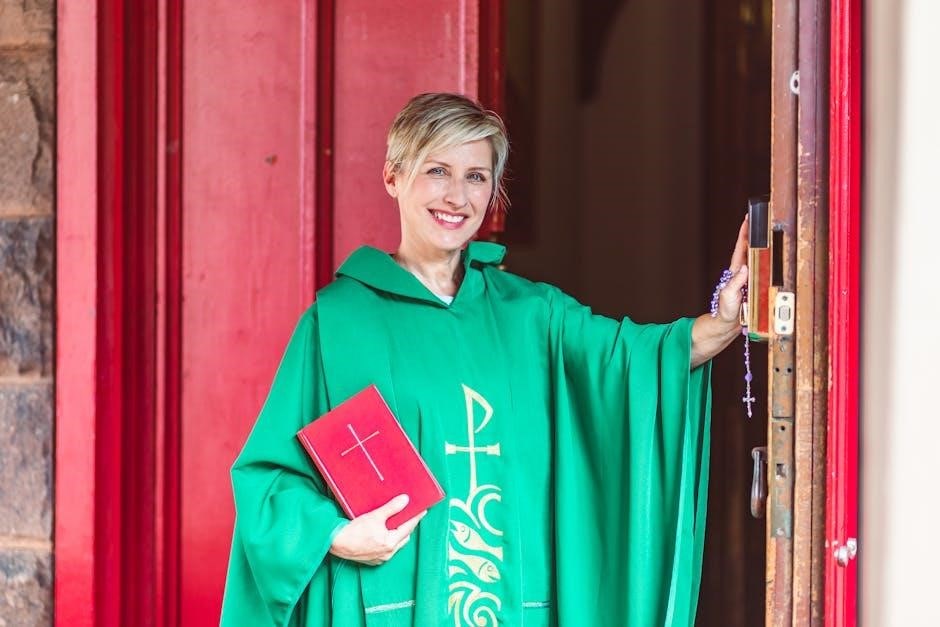The Scriptural Rosary combines traditional prayer with specific Bible readings, enhancing meditation by connecting prayers to Scripture. It deepens faith and reflection, offering a structured guide for devotion.
1.1 Definition and Purpose
The Scriptural Rosary is a devotional prayer that combines the traditional Rosary with specific biblical passages, grounding each mystery in Scripture. Its purpose is to deepen meditation and reflection by connecting the prayers to the life of Christ and the Virgin Mary. The Joyful Mysteries, in particular, focus on the early life of Jesus, from the Annunciation to the Finding in the Temple. By incorporating Scripture, the Scriptural Rosary enhances the prayer experience, making it more meaningful and faith-enriching. It serves as a tool for fostering devotion, contemplation, and a deeper intimacy with God through the mysteries of the Rosary.

1.2 Historical Background

The Scriptural Rosary traces its roots to the traditional Rosary, which originated in the Catholic Church as a devotion to Mary and the mysteries of Christ’s life. Over time, the inclusion of Scripture became a natural evolution, enriching the prayer with biblical context. The modern Scriptural Rosary gained popularity as a way to deepen meditation by aligning each mystery with specific passages. This approach reflects the Church’s emphasis on Scripture, particularly highlighted by Pope John Paul II’s introduction of the Luminous Mysteries in 2002. The Scriptural Rosary has since become a powerful tool for fostering devotion and reflection, bridging tradition with biblical depth.
1.3 Structure and Mysteries
The Scriptural Rosary is structured around four sets of mysteries: Joyful, Luminous, Sorrowful, and Glorious, each containing five events from Scripture. The Joyful Mysteries focus on the early life of Jesus, including the Annunciation, Visitation, Nativity, Presentation, and Finding in the Temple; Each mystery is paired with a decade of prayers, beginning with the Our Father, followed by ten Hail Marys, and concluding with the Glory Be. A scriptural passage is recited before each mystery to deepen meditation. This format allows for a contemplative and biblically grounded prayer experience, with downloadable PDF guides available to aid in reflection and devotion.

The Joyful Mysteries Explained
The Joyful Mysteries reflect on key events in Jesus’ early life, fostering meditation and reflection through scriptural connections, enhancing prayer with biblical depth and meaning.
2.1 The Annunciation
The Annunciation, the first Joyful Mystery, marks the angel Gabriel’s visit to Mary, announcing she would bear Jesus. This event, rooted in Luke 1:26-38, highlights Mary’s faith and obedience, setting the stage for the Incarnation. It invites reflection on trust and surrender to God’s will, emphasizing the significance of Mary’s “Yes” in salvation history. This mystery is a powerful reminder of God’s plan and the beginning of Jesus’ journey on earth, fostering devotion and meditation on the divine message and Mary’s pivotal role.
2.2 The Visitation
The Visitation, the second Joyful Mystery, reflects Mary’s journey to visit her cousin Elizabeth, as described in Luke 1:39-56. This profound moment of joy and faith highlights Mary’s compassion and haste in serving others. Upon greeting Elizabeth, John the Baptist leaps in the womb, symbolizing the unborn saint’s recognition of Jesus’ presence. Mary’s Magnificat, a hymn of praise, underscores her humility and trust in God. This mystery invites reflection on the value of service, the power of faith, and the communal celebration of life, emphasizing the importance of nurturing relationships and rejoicing in God’s plan;
2.3 The Nativity
The Nativity, the third Joyful Mystery, recounts the birth of Jesus in Bethlehem, as described in Luke 2:1-7. Mary and Joseph, unable to find lodging, welcomed Jesus into the world in a humble manger. This moment of profound humility and divine love embodies the essence of God’s plan to save humanity. The Nativity invites us to reflect on the simplicity and grace of Jesus’ arrival, emphasizing the importance of trusting in God’s providence. The manger scene, surrounded by the quiet adoration of Mary, Joseph, and the shepherds, reminds us of the beauty of faith and the transformative power of love and surrender.
2.4 The Presentation
The Presentation, the fourth Joyful Mystery, reflects on Mary and Joseph presenting Jesus in the Temple (Luke 2:22-38). This act of obedience to Jewish law highlights their devotion and faith. Simeon, a righteous man, recognizes Jesus as the Messiah, prophesying His role in salvation and Mary’s future sorrow. Anna, a prophetess, also acknowledges Jesus, spreading word of His arrival. This mystery underscores the fulfillment of prophecy and the divine plan unfolding through Jesus’ life. It invites reflection on surrendering to God’s will and trusting in His timing, even when the future holds unknown challenges. The Presentation emphasizes the importance of faith and obedience in walking with God.
2.5 The Finding in the Temple
The fifth Joyful Mystery recounts the story of Mary and Joseph finding Jesus in the Temple after three days of searching (Luke 2:41-52). At 12 years old, Jesus was engaged in deep discussions with Temple teachers, astonishing them with His wisdom. Mary expressed her anguish and concern, while Jesus replied, “Did you not know that I must be in my Father’s house?” This mystery highlights Jesus’ growing awareness of His divine mission and Mary’s faith amidst uncertainty. It invites reflection on trusting God’s plan, even when faced with challenges or misunderstandings, and surrendering to His will with courage and devotion.

Scriptural References for the Joyful Mysteries

The Joyful Mysteries are rooted in Luke’s Gospel, with key passages like Luke 1:26-38 (Annunciation), 1:39-56 (Visitation), 2:1-7 (Nativity), 2:22-38 (Presentation), and 2:41-52 (Finding in the Temple), providing biblical depth for meditation and prayer.
3.1 Luke 1:26-38 (The Annunciation)
Luke 1:26-38 narrates the Annunciation, where the angel Gabriel announces to Mary that she will bear Jesus, the Son of God. Mary, though troubled, humbly accepts, trusting God’s plan. This passage emphasizes faith, obedience, and divine providence, serving as the biblical foundation for the first Joyful Mystery. It highlights Mary’s pivotal role in salvation history, making it a central scriptural reference for the Scriptural Rosary, fostering deeper reflection on God’s grace and Mary’s fiat during prayer.
3.2 Luke 1:39-56 (The Visitation)
Luke 1:39-56 recounts the Visitation, where Mary visits her cousin Elizabeth, who is carrying John the Baptist. The passage highlights the Holy Spirit’s role in recognizing the Messiah and the joy shared between the two women. Elizabeth praises Mary for her faith, and Mary responds with the Magnificat, a hymn of praise to God. This event underscores the themes of faith, joy, and the miraculous work of the Holy Spirit. It serves as a key scriptural foundation for the second Joyful Mystery, encouraging reflection on the divine plan and the importance of humility and trust in God.
3.3 Luke 2:1-7 (The Nativity)
Luke 2:1-7 narrates the Nativity, detailing Jesus’s birth in Bethlehem. Mary and Joseph, compelled by a census, journey to Bethlehem, where Jesus is born in a manger due to the lack of lodging. This humble birthplace underscores divine humility and simplicity. The passage emphasizes God’s plan unfolding in ordinary circumstances, highlighting faith and trust; The Nativity reflects the joy of the Incarnation, central to the third Joyful Mystery, inviting prayer and reflection on God’s love and the gift of Jesus to humanity.
3.4 Luke 2:22-38 (The Presentation)
Luke 2:22-38 recounts the Presentation of Jesus in the Temple, where Mary and Joseph fulfill Mosaic Law by offering their firstborn son to God. Mary undergoes purification, and they present Jesus with humble offerings. Simeon, guided by the Holy Spirit, recognizes Jesus as the Messiah and prophesies His mission, while Anna, a devout prophetess, praises God for the redemption He brings. This passage highlights obedience to God’s law and the revelation of Jesus as the Savior. It invites reflection on surrendering to God’s will and trusting in His divine plan, central to the fourth Joyful Mystery of the Rosary.
3.5 Luke 2:41-52 (The Finding in the Temple)
Luke 2:41-52 narrates the fifth Joyful Mystery, the Finding in the Temple. At 12 years old, Jesus remains in Jerusalem after the Passover, engaging scholars in discussion. His parents, searching for Him, find Him in the Temple, where He declares His mission: “I must be about My Father’s business.” This passage underscores Jesus’ divine purpose and Mary’s maternal concern. The event highlights the balance between familial duties and divine vocation, inviting reflection on discerning God’s will in life. It concludes the Joyful Mysteries, emphasizing Mary’s faith and trust in God’s plan for her Son.

How to Pray the Scriptural Rosary
The Scriptural Rosary combines traditional prayers with Bible passages, fostering reflection and deepening faith through structured meditation and devotion, using guides for convenience and enhancing spiritual focus.
4.1 Understanding the Format
The Scriptural Rosary format intertwines traditional prayers with relevant Bible verses, creating a structured yet flexible framework for meditation. Each mystery begins with a scripture passage, followed by the Our Father, Hail Marys, and a Glory Be. This integration allows for a deeper connection to the biblical narrative, enhancing the spiritual experience. The format is designed to be accessible, with guides like PDFs offering clear step-by-step instructions. By aligning prayer with scripture, individuals can reflect more profoundly on the mysteries, fostering a richer and more meaningful devotion. This structured approach ensures consistency while encouraging personal reflection and communal prayer.
4.2 Praying with Scripture
Praying with Scripture in the Scriptural Rosary involves reciting specific Bible verses before each decade, aligning prayer with the biblical narrative. This practice enriches meditation by grounding the mysteries in their scriptural origins. For example, the Annunciation is preceded by Luke 1:26-38, while the Nativity draws from Luke 2:1-7. These verses provide a focal point for reflection, deepening understanding and fostering a personal connection to the events. The integration of Scripture ensures that prayer remains rooted in the Word of God, making the Rosary a powerful tool for spiritual growth and contemplation. This method encourages a more engaging and meaningful prayer experience.
4.3 Incorporating Reflection
Incorporating reflection into the Scriptural Rosary enhances its spiritual impact by encouraging deeper contemplation of each mystery. After reciting the prayers and Scripture, pause to reflect on the significance of the event and its relevance to your life. For instance, during the Annunciation, consider Mary’s surrender to God’s will and how it inspires your own trust in His plan. Use the scriptural passages as a focal point, allowing the words to guide your thoughts and heart. This practice fosters a more personal and meaningful connection to the mysteries, making prayer a transformative experience rather than a mere recitation of words.
4.4 Using the PDF Guide
A Scriptural Rosary PDF guide provides a structured format for praying the Rosary, combining prayers with relevant Scripture passages for each mystery. It is easily downloadable and printable, making it convenient to use during personal or group prayer. The guide includes the Joyful, Sorrowful, Luminous, and Glorious Mysteries, each accompanied by biblical references to deepen meditation. Its clear layout ensures a smooth flow, allowing users to focus on reflection without distraction. Many guides also include traditional Catholic prayers, such as the Hail Mary and Our Father, along with optional devotions. This resource is invaluable for those seeking to enhance their Rosary practice with a scriptural foundation.

Benefits of Praying the Scriptural Rosary
The Scriptural Rosary enriches prayer life by connecting it to Scripture, deepening faith, enhancing meditation, strengthening devotion, and fostering community prayer. It offers a meaningful way to reflect on sacred mysteries with others.
5.1 Deepening Faith
Praying the Scriptural Rosary deepens faith by immersing the believer in biblical narratives. Each mystery, rooted in Scripture, provides a vivid connection to key events in salvation history, fostering a richer understanding of God’s plan. By reflecting on these sacred stories, individuals develop a stronger relationship with Christ and the Virgin Mary. The integration of Scripture enhances meditation, allowing prayers to become more meaningful and personal. This practice not only strengthens spiritual devotion but also encourages a deeper appreciation for the mysteries of the faith, making prayer a transformative experience that nourishes the soul and reinforces Christian values.
5.2 Enhancing Meditation
The Scriptural Rosary enhances meditation by weaving Bible verses into each prayer, creating a contemplative atmosphere. This method encourages believers to reflect on the life of Christ and the Virgin Mary through specific scriptural references. By focusing on the Joyful Mysteries, such as the Annunciation or the Nativity, individuals can immerse themselves in the divine narratives. The integration of Scripture helps quiet the mind and fosters a deeper connection to the mysteries being prayed. This practice also encourages visualizing biblical scenes, making meditation more vivid and engaging. Ultimately, the Scriptural Rosary serves as a powerful tool to enrich prayer and deepen spiritual reflection, drawing believers closer to God’s Word.
5.3 Strengthening Devotion
The Scriptural Rosary strengthens devotion by immersing believers in the Word of God, fostering a deeper connection to the mysteries of Christ and the Virgin Mary. By integrating sacred Scripture into each prayer, individuals are drawn into the divine narratives, such as the Annunciation and the Nativity, enhancing their spiritual engagement. This practice encourages a more heartfelt participation in the Rosary, inspiring greater love for Christ and His Mother. Regularly praying the Scriptural Rosary cultivates consistency in prayer life and deepens one’s commitment to faith, ultimately strengthening devotion and fostering a more intimate relationship with God through Scripture and tradition.
5.4 Fostering Community Prayer
The Scriptural Rosary fosters community prayer by providing a shared, structured format that unites individuals in devotion. Praying the Rosary with others, whether in parish groups, families, or online communities, strengthens spiritual bonds and creates a sense of unity. The use of specific Scriptures for each mystery ensures everyone is reflecting on the same divine events, fostering a collective meditation. This communal approach to prayer not only enhances personal faith but also builds a supportive and prayerful community. Resources like the Joyful Mysteries PDF guide further facilitate group participation, making it easier for all to engage in this meaningful tradition together.

Additional Resources
Downloadable PDF guides, Rosary cards, and online communities provide convenient ways to pray the Scriptural Rosary. Prayer apps also offer accessible tools for deeper devotion and meditation.

6.1 Downloadable PDF Guides
Downloadable PDF guides for the Scriptural Rosary offer a structured and accessible way to pray the Joyful Mysteries. These guides typically include traditional Catholic prayers, relevant Scripture passages, and a clear, step-by-step format. Many PDFs are free to download and print, making them ideal for personal or group use. They often feature the Douay-Rheims Bible text for accuracy and include reflections to deepen meditation. Websites like Everyday Prayer Co provide these resources, ensuring that users can easily incorporate Scripture into their Rosary devotion. These guides are perfect for those seeking to enrich their prayer life with biblical depth and clarity, fostering a more meaningful connection to the mysteries of the Rosary.
6.2 Rosary Cards
Rosary Cards are convenient, credit card-sized resources designed to aid in praying the Scriptural Rosary. They typically include the Joyful, Sorrowful, Luminous, and Glorious Mysteries, along with relevant Bible verses and prayers. These cards are portable, making it easy to pray anywhere. Many feature a clear, step-by-step format, ensuring users can follow along effortlessly. Additionally, they often include images or icons to enhance meditation. Rosary Cards are available in both physical and digital formats, allowing users to choose their preferred method. They are ideal for personal or group prayer, providing a structured and accessible way to deepen one’s devotion to the Rosary and its scriptural foundations.
6.3 Online Communities
Online communities provide a vibrant space for sharing resources and experiences related to the Scriptural Rosary. These forums often offer downloadable materials, including Joyful Mysteries PDF guides, prayer schedules, and scripted meditations. Members can engage in discussions, share reflections, and participate in virtual Rosary sessions. Many communities host live events, such as group prayers and educational webinars, fostering a sense of unity among participants. These platforms also serve as hubs for requesting prayers, sharing testimonials, and gaining inspiration from others’ spiritual journeys. By joining these communities, individuals can deepen their devotion and connect with like-minded individuals worldwide, enhancing their Scriptural Rosary practice.
6.4 Prayer Apps
Prayer apps are a convenient way to deepen your Scriptural Rosary practice. Many apps offer downloadable guides, including Joyful Mysteries PDFs, along with interactive features like reminders, audio guides, and customizable prayer settings. These tools help users stay consistent in their devotion, even on-the-go. Some apps include community features, allowing users to join group prayers or share reflections. They often provide scripture passages, meditation prompts, and step-by-step instructions for praying the Rosary. Additionally, apps may offer tracking features to monitor progress and set goals. This modern approach makes the Scriptural Rosary accessible to everyone, blending tradition with technology to enhance spiritual growth and connection.



